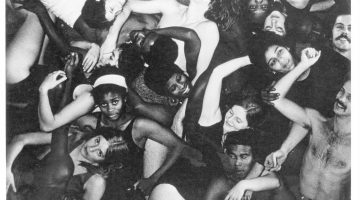Contributed by John Held, Jr.
March 8-April 30, 2013
501 Third Street
San Francisco

Graham Gillmore. Mysticism Scale (Detail). 2012. Oil on Panel 72" x 60". Image courtesy of John Held, Jr.
In my world – the Mail Art world- there is a long history of Visual Poetry. It’s contemporary heritage starts with the Fluxus artists, like Dick Higgins, who toward the end of his life went back to school to get a doctorate in Pattern Poetry, which began back in the Middle Ages. Another Fluxus artist, Emmett Williams, wrote the first anthology of Concrete Poetry. These are primarily visual artists, who sought a connection with equal literary interests. It is little wonder that Higgins is credited with coining the term “intermedia” in the early sixties.

Graham Gillmore. Case Closed (Detail) (n.d.). Acrylic on paper. 96" x 83". Courtesy of John Held, Jr.
Modern visual poets (many of them ensconced in Mail Art, which is an umbrella for myriad marginal art forms like Visual Poetry) hark back to English language composers like William Blake and Lewis Carroll. The French proudly list their literary predecessors as Mallarmé and the Calligrammes of Apollinaire. Americans have their e. e. cummings, and more recently Ed Ruscha, whose artist books and oil on canvas text based works are duly noted, sanctioned and celebrated by the mainstream artworld.

Graham Gillmore. Sigh Co. Farm Ecology (detail) (n.d.). Oil on panel. 48" x 54". Image courtesy of John Held, Jr.
Karl Kempton, a poet who has been tracking the field for more then several decades, writes that, “The actual modern process of freeing the word began among cubist painters quickly followed by freed words in the collage. Within the same time frame, Marinetti wrote the Futurist Manifesto in which he called for the freeing of the word from the format of free verse. This was the founding moment of the Italian Futurists, a group that significantly influenced the visual poem at that time. The Russian Futurists had an equal impact. By studying Fauvism, Cubism, Collage, Italian Futurism, Russian Futurism [Zaum], Imagism, Orphism, Voticism, Constructivism, Dada, De Stijl, Surrealism, Bauhaus, various Japanese avant-garde movements of the 1920s, Lettrism, Kinetic, Concrete Poetry, Fluxus, Pop, Op, Visual Poetry, Correspondence/Mail Art, Russian Transfurism, Minimalism, Conceptualism, and Book Art one can find considerable numbers of works classified as visual poetry. While incomplete, this is an outline of movements and or groupings to follow the evolution of the visual poem.”
The quote by Kempton appears in the book, “The Last Vispo: Anthology: Visual Poetry 1998-2008” (Fantagraphics, Seattle, 2012). Another essayist in the book, Los Angeles critic Peter Frank, writes that, “The computer will not kill the book, but liberate it. By relieving the book of its lexical responsibility, the computer will do for the book what photography did for painting two centuries ago: allow it to become a self-reflexive discipline, an investigation of medium and format and content and history whose resonance deepens and complectifies, spawning experiments and arguments, contradictions and unanticipated pathways to entirely new artistic possibilities.”
And so we arrive at the works of Graham Gillmore whose works are described in an introduction on the online catalog, by Thomas Breidenbach, as “Employing puns and punch lines both lewd and mawkish, and referencing clichés, board games, rebuses, barroom banter, and graffiti, his paintings are by subtle turns playful, earnest, and caustic. At times surrounded by bubbles that are interlinked via intestinal networks of lines, the letters and syllables he depicts take on lives of their own, as through reverberating in the mind suggestively, or suspiciously connoting an overwhelming variety of possible meanings that appear to jostle for recognition.”

Graham Gillmore, Mondrain/Wetdream, 2013. Acrylic on canvas, 60" x 40". Image courtesy of John Held, Jr.
Spanning nearly a decade of work, Gillmore’s oils and acrylics on paper and canvas have been curated by Charles Linder, one of the ablest adjunct curators in San Francisco, whose past exhibitions at Refusalon, Lincart, Ever Gold, and elsewhere have been among the most innovative in The City. Gillmore’s more recent works including “Mysticism Scale” (2012), “Psych Test” (2012), Sigh Co Farm Ecology” (undated), and “Vu Da Je” (2013) have a high gloss finish with the words gouged rather than painted as in previous works. These newer works stand out in my estimation, adding a growing visual sophistication and evolution to the earlier works. The older works are not without interest, revealing a history of wedding outsider art and literary inclination.
This predisposition in melding high/low forms is nowhere to be seen to greater effect than in, “Mondrain/Wetdream,” (2013), the artist riffing on alliteration and allusion. Like all of Gillmore’s works they would equally be at home in the boudoir or the boardroom.




